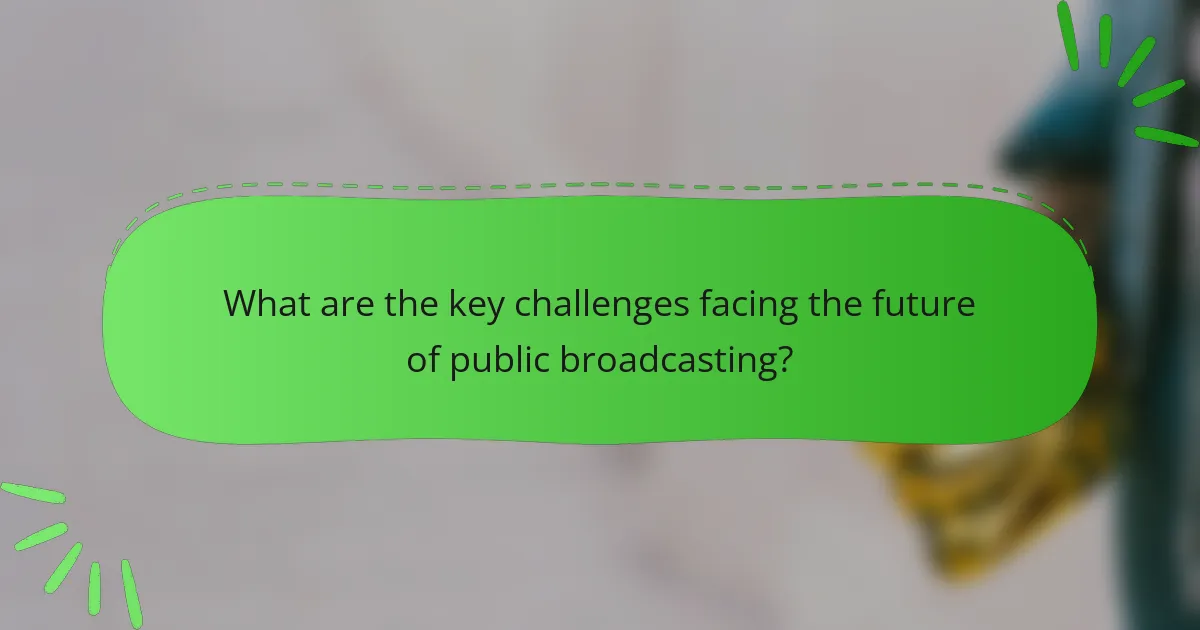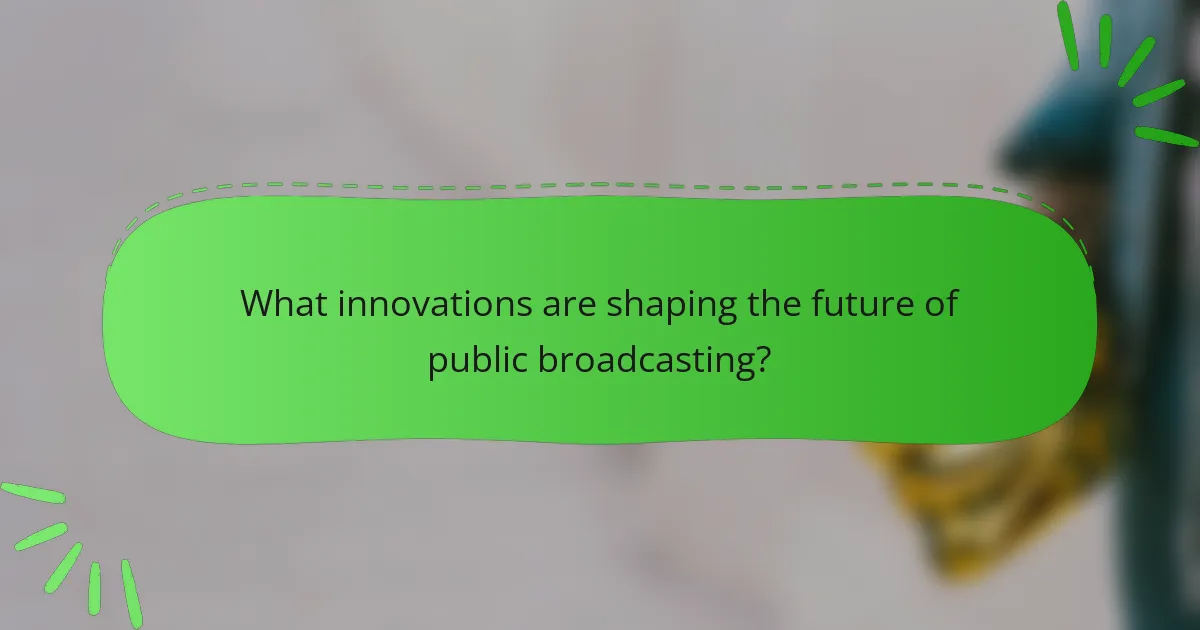Public broadcasting is facing key challenges that include funding sustainability, audience engagement, and regulatory pressures. The decline of traditional revenue sources, such as government support and license fees, is compounded by competition from digital platforms. To remain relevant, public broadcasters must innovate by adopting digital platforms, interactive content, and data-driven programming that cater to evolving viewer preferences. Diversifying funding sources through sponsorships, donations, and community engagement is crucial for enhancing financial stability. This article will explore these challenges and innovations shaping the future of public broadcasting.

What are the key challenges facing the future of public broadcasting?
Key challenges facing the future of public broadcasting include funding sustainability, audience engagement, and regulatory pressures. Funding is increasingly threatened by competition from digital platforms. Traditional revenue sources, such as government support and license fees, are declining. Audience engagement is challenging due to changing viewing habits and preferences. Public broadcasters must adapt to digital consumption trends. Regulatory pressures also impact operational flexibility. Compliance with evolving regulations can strain resources. These challenges require innovative solutions to ensure public broadcasting remains relevant and effective.
How do funding models influence public broadcasting?
Funding models significantly influence public broadcasting by determining its financial sustainability and operational independence. Different models, such as license fees, government funding, and advertising revenue, shape the content and services provided. For instance, license fee-funded broadcasters often prioritize public interest content over commercial viability. This can lead to a broader range of programming that serves diverse audiences. In contrast, advertising-based models may prioritize popular content to attract viewers, potentially sacrificing educational or niche programming. Research shows that public broadcasters funded by stable government allocations tend to have more consistent programming quality and less susceptibility to market fluctuations. This stability allows for long-term planning and investment in innovative content. Therefore, the choice of funding model directly impacts the mission, quality, and audience reach of public broadcasting entities.
What are the traditional funding sources for public broadcasting?
Traditional funding sources for public broadcasting include government grants, viewer donations, and corporate sponsorships. Government grants provide essential financial support from federal, state, and local entities. In the United States, the Corporation for Public Broadcasting (CPB) plays a significant role in distributing federal funds to public broadcasters. Viewer donations, often solicited during fundraising drives, contribute substantially to operating budgets. Corporate sponsorships offer financial backing in exchange for promotional opportunities. These funding sources are crucial for maintaining the independence and quality of public broadcasting services. According to the CPB, federal funding accounts for about 15% of public broadcasting revenues, highlighting its importance.
How do alternative funding models impact public broadcasting sustainability?
Alternative funding models enhance public broadcasting sustainability by diversifying revenue sources. These models include crowdfunding, sponsorships, and partnerships with private entities. They reduce reliance on government funding, which can be unstable. For instance, the Pew Research Center reported that public broadcasters in the U.S. saw a 10% decrease in federal funding between 2010 and 2020. By adopting alternative models, broadcasters can secure more consistent income. This financial stability allows for improved programming and technological upgrades. Additionally, audience engagement through crowdfunding can strengthen community ties. Overall, alternative funding models contribute to the resilience of public broadcasting in changing economic climates.
What regulatory challenges affect public broadcasting?
Public broadcasting faces several regulatory challenges. One major challenge is compliance with content regulations. These regulations dictate programming standards and ensure diversity in viewpoints. Another challenge is funding limitations imposed by government policies. These limitations can restrict operational budgets and affect service delivery. Additionally, public broadcasters must navigate licensing requirements, which can vary significantly by region. The rise of digital media also poses challenges in adapting existing regulations to new platforms. Furthermore, public broadcasting entities often contend with political pressures that can influence editorial independence. These regulatory hurdles can impact the sustainability and effectiveness of public broadcasting services.
How do government policies shape public broadcasting operations?
Government policies significantly influence public broadcasting operations. These policies dictate funding levels, regulatory frameworks, and content guidelines. For instance, public broadcasters often rely on government grants or license fees. The allocation of these funds can affect programming choices and operational capabilities. Additionally, policies establish standards for content, ensuring it serves public interest. This includes mandates for diversity, educational programming, and accessibility. Regulations also govern the technical aspects of broadcasting, such as spectrum allocation. Historical examples show that changes in government leadership can lead to shifts in funding priorities and operational autonomy. Thus, government policies play a crucial role in shaping the landscape of public broadcasting.
What role do international regulations play in public broadcasting?
International regulations play a crucial role in public broadcasting by establishing standards for content, funding, and operational practices. These regulations ensure that public broadcasters operate in a manner that promotes diversity, accessibility, and accountability. For instance, the European Union’s Audiovisual Media Services Directive sets guidelines that member states must follow, including requirements for public service obligations. Such regulations help maintain editorial independence and protect against political interference. They also facilitate cross-border cooperation among broadcasters, enhancing content sharing and cultural exchange. Overall, international regulations are essential for fostering a robust public broadcasting environment that serves the public interest.

What innovations are shaping the future of public broadcasting?
Innovations shaping the future of public broadcasting include digital platforms, interactive content, and data-driven programming. Digital platforms allow public broadcasters to reach wider audiences through streaming services. Interactive content engages viewers by enabling participation in real-time discussions and polls. Data-driven programming utilizes audience analytics to tailor content to viewer preferences. These innovations enhance accessibility and relevance in a rapidly changing media landscape. For instance, the rise of podcasts has expanded public broadcasting’s reach, with NPR reporting over 100 million monthly podcast downloads in 2020. Additionally, mobile applications are being developed to provide on-the-go access to content, further increasing audience engagement.
How is technology transforming public broadcasting?
Technology is transforming public broadcasting by enhancing content delivery and audience engagement. Digital platforms enable broadcasters to reach wider audiences beyond traditional radio and television. Streaming services allow for on-demand access to programs, increasing viewer flexibility. Social media integration fosters real-time interaction between broadcasters and audiences. Data analytics helps broadcasters understand viewer preferences, tailoring content accordingly. High-definition and virtual reality technologies improve the quality of broadcasts. Mobile applications facilitate access to public broadcasting content anytime, anywhere. These advancements collectively modernize public broadcasting, ensuring it remains relevant in a digital age.
What new platforms are emerging for public broadcasting content delivery?
New platforms emerging for public broadcasting content delivery include streaming services, mobile apps, and social media channels. Streaming services like PBS Passport and BBC iPlayer are gaining traction. These platforms allow users to access content on-demand. Mobile apps provide easy access to live broadcasts and recorded shows. Social media channels facilitate real-time engagement with audiences. Innovations in technology are driving these developments. The shift towards digital consumption is reshaping public broadcasting strategies. These trends reflect changing viewer preferences and habits.
How does audience engagement change with technological advancements?
Audience engagement evolves significantly with technological advancements. New technologies enable more interactive and personalized experiences. For instance, social media platforms allow real-time feedback and participation. Streaming services provide on-demand content, increasing viewer control. Data analytics offer insights into audience preferences, enhancing targeted content delivery. A study by the Pew Research Center indicates that 53% of U.S. adults engage with news through social media. This shift shows that technology fosters active participation rather than passive consumption. Enhanced connectivity through mobile devices also facilitates access to diverse content, further impacting engagement levels.
What are the implications of digital media on public broadcasting?
Digital media significantly impacts public broadcasting by altering content delivery and audience engagement. Traditional broadcasting faces competition from streaming platforms, leading to audience fragmentation. Public broadcasters must adapt to digital consumption trends, such as on-demand viewing and social media interaction. This shift influences funding models, as traditional revenue sources like advertising decline.
Moreover, digital media enables broader reach and accessibility for public broadcasters. For instance, online platforms allow content to reach diverse demographics, including younger audiences. Enhanced interactivity through digital channels fosters community engagement and feedback. However, challenges arise in maintaining quality and journalistic standards amidst the rapid content production pace online.
Public broadcasting organizations must navigate these changes to sustain relevance and funding in a digital landscape. This adaptation is crucial for fulfilling their public service mission effectively.
How do social media and online platforms affect public broadcasting reach?
Social media and online platforms significantly enhance the reach of public broadcasting. These platforms allow broadcasters to share content widely and instantly. Public broadcasters can engage with diverse audiences beyond traditional viewership. Social media facilitates real-time interaction and feedback from viewers. For instance, the BBC reported a 50% increase in audience engagement through social media initiatives. Online platforms also provide data analytics, helping broadcasters understand audience preferences. This data-driven approach enables tailored content delivery. Consequently, public broadcasting can adapt to changing viewer habits and interests.
What challenges does digital content pose for traditional public broadcasting models?
Digital content challenges traditional public broadcasting models by increasing competition for audience attention. Viewers now have access to diverse online platforms offering instant content. This shift reduces the audience share of public broadcasters. Additionally, funding models are strained as advertisers favor digital platforms. Public broadcasters face pressure to adapt to changing viewer preferences. The rise of on-demand content alters scheduling and programming strategies. Furthermore, maintaining quality content in a digital landscape requires significant investment. These factors collectively threaten the sustainability of traditional public broadcasting.

What strategies can enhance the viability of public broadcasting?
Diversifying funding sources can enhance the viability of public broadcasting. This includes incorporating sponsorships, donations, and grants. Public broadcasters can also explore partnerships with private organizations. Engaging the community through local events can increase viewer loyalty and support. Additionally, leveraging digital platforms can expand audience reach and engagement. Implementing innovative content strategies can attract new viewers. Evidence shows that public broadcasters with varied funding experience greater financial stability. For instance, the Corporation for Public Broadcasting reported that stations with multiple revenue streams are less vulnerable to budget cuts.
How can public broadcasting adapt to changing audience preferences?
Public broadcasting can adapt to changing audience preferences by embracing digital platforms and enhancing audience engagement. Transitioning to online streaming services increases accessibility for younger demographics. Incorporating interactive content fosters a two-way communication channel with viewers. Additionally, utilizing data analytics helps tailor programming to audience interests. Collaborating with community organizations can ensure content relevance. These strategies have been effective in various public broadcasting systems, demonstrating adaptability to audience needs. For example, NPR has successfully expanded its digital presence, resulting in a significant increase in younger listeners.
What role does content diversity play in audience retention?
Content diversity significantly enhances audience retention. It engages a broader range of interests and preferences. Diverse content caters to various demographics, increasing overall viewership. Research shows that audiences are more likely to return to platforms offering varied content types. According to a Nielsen report, 68% of viewers prefer platforms that provide a mix of genres. This variety keeps content fresh and appealing. Additionally, it fosters a sense of community among diverse audience segments. Engaging different cultural perspectives can deepen viewer loyalty. Thus, content diversity is crucial for maintaining and growing audience engagement.
How can public broadcasters leverage partnerships for growth?
Public broadcasters can leverage partnerships for growth by collaborating with various organizations and stakeholders. These partnerships can enhance content creation, broaden audience reach, and share resources. For example, joint ventures with educational institutions can lead to innovative programming and increased funding opportunities. Collaborations with technology companies can improve distribution and access to digital platforms. Additionally, partnerships with local businesses can foster community engagement and sponsorships. Research indicates that public broadcasters that actively engage in partnerships often see increased funding and audience metrics. A study by the Pew Research Center shows that collaboration can lead to a 20% increase in viewership for public broadcasting entities.
What best practices can be implemented for sustainable funding?
Implementing diversified funding sources is a best practice for sustainable funding. This approach reduces reliance on a single revenue stream. Public broadcasters can explore grants, donations, and partnerships. Engaging with the community fosters support and increases funding opportunities. Transparency in financial reporting builds trust with stakeholders. Regularly evaluating funding strategies ensures alignment with changing conditions. Research indicates that organizations with diverse funding are more resilient during economic downturns. A study by the National Endowment for the Arts found that diversified funding improves long-term stability for public entities.
How can public broadcasters effectively engage with local communities?
Public broadcasters can effectively engage with local communities by fostering collaboration and participation. They should develop local content that reflects community interests and needs. This can include news, cultural programming, and educational resources.
Public broadcasters can also host community forums and events to encourage dialogue. Engaging with local organizations and leaders can strengthen these connections. Utilizing social media platforms allows for real-time interaction and feedback from the audience.
Research shows that local programming increases viewer loyalty and community trust. According to a study by the Pew Research Center, 70% of local news consumers believe local news is important to their community. This highlights the value of tailored content in building engagement.
What are the most successful case studies of funding innovation in public broadcasting?
Successful case studies of funding innovation in public broadcasting include the BBC’s “Digital Strategy” and NPR’s “Tiny Desk Concerts.” The BBC implemented its Digital Strategy to enhance online content delivery. This initiative increased audience engagement significantly, with a reported 90% of UK adults accessing BBC content online. NPR’s Tiny Desk Concerts showcased emerging artists, attracting millions of views. This innovative funding model relied on partnerships with sponsors, generating substantial revenue. Both examples illustrate effective funding strategies that adapt to changing media landscapes.
What practical steps can be taken to address regulatory challenges?
Engaging with regulatory challenges requires a multi-faceted approach. First, stakeholders should conduct a comprehensive analysis of existing regulations. This helps identify specific areas that hinder progress. Second, collaboration with regulatory bodies is crucial. Open dialogues can lead to more favorable regulations. Third, advocacy for policy changes can be effective. Mobilizing public support can influence legislative priorities. Fourth, investing in compliance technology streamlines adherence to regulations. This reduces the burden on organizations. Finally, continuous education on regulatory updates is essential. Keeping informed allows organizations to adapt proactively. These steps collectively enhance the ability to navigate regulatory challenges effectively.
The main entity of this article is public broadcasting, which faces significant challenges related to funding models and regulatory pressures. Key issues include the sustainability of traditional funding sources, the impact of digital media on audience engagement, and the need for innovative solutions to adapt to changing viewer preferences. The article explores various funding models, including government support and alternative sources, while examining how regulatory frameworks shape operations and content delivery. Additionally, it highlights the role of technology and partnerships in enhancing public broadcasting’s viability and community engagement.